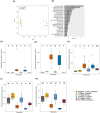Phage biocontrol success of bacterial wilt depends on synergistic interactions with resident rhizosphere microbiota
- PMID: 39539110
- PMCID: PMC11561305
- DOI: 10.1111/1751-7915.70049
Phage biocontrol success of bacterial wilt depends on synergistic interactions with resident rhizosphere microbiota
Abstract
Phages can successfully be used in vitro and in planta to biocontrol the phytopathogenic Ralstonia solanacearum bacterium-the causal agent of bacterial wilt disease. However, phage biocontrol outcomes are still variable, and it is unclear what causes this. In this study, we assessed the efficiency of four phages in controlled in vitro and in planta experiments in all one- and two-phage combinations. We found that using phages in combination did not improve the phage biocontrol efficiency relative to single phage treatments, while certain phages and their combinations were more effective than the others. High intra-treatment variability in phage efficiency was observed across all phage treatments, which was associated with clear shifts in microbiome composition, a reduction in R. solanacearum and an increase in phage densities. We further identified the bacterial taxa that were associated with these 'shifted' microbiomes and conducted additional plant growth experiments, demonstrating that some of the enriched bacterial species could protect plants from R. solanacearum infections-a pattern which was also observed using partial least squares path modelling (PLS-PM). Together, these results suggest that phages could open niche space for beneficial bacteria by reducing pathogen densities and that variability in phage biocontrol outcomes is rhizosphere microbiome-dependent, which can introduce between-replicate variation, even in controlled greenhouse conditions.
© 2024 The Author(s). Microbial Biotechnology published by John Wiley & Sons Ltd.
Conflict of interest statement
The authors declare that they have no competing interests.
Figures





Similar articles
-
Phages enhance both phytopathogen density control and rhizosphere microbiome suppressiveness.mBio. 2024 Jun 12;15(6):e0301623. doi: 10.1128/mbio.03016-23. Epub 2024 May 23. mBio. 2024. PMID: 38780276 Free PMC article.
-
Phage combination therapies for bacterial wilt disease in tomato.Nat Biotechnol. 2019 Dec;37(12):1513-1520. doi: 10.1038/s41587-019-0328-3. Epub 2019 Dec 2. Nat Biotechnol. 2019. PMID: 31792408
-
Rhizosphere phage communities drive soil suppressiveness to bacterial wilt disease.Microbiome. 2023 Feb 1;11(1):16. doi: 10.1186/s40168-023-01463-8. Microbiome. 2023. PMID: 36721270 Free PMC article.
-
Advances in isolated phages that affect Ralstonia solanacearum and their application in the biocontrol of bacterial wilt in plants.Lett Appl Microbiol. 2024 Apr 8;77(4):ovae037. doi: 10.1093/lambio/ovae037. Lett Appl Microbiol. 2024. PMID: 38573829 Review.
-
Novel weapon-aided plant protection in the underground battlefield.Plant Signal Behav. 2024 Dec 31;19(1):2404808. doi: 10.1080/15592324.2024.2404808. Epub 2024 Sep 16. Plant Signal Behav. 2024. PMID: 39283922 Free PMC article. Review.
Cited by
-
Phage Cocktail Alleviates Bacterial Canker of Kiwifruit by Modulating Bacterial Community Structure in Field Trial.Microorganisms. 2025 Jan 7;13(1):104. doi: 10.3390/microorganisms13010104. Microorganisms. 2025. PMID: 39858873 Free PMC article.
-
Harnessing Bacteriophages for Sustainable Crop Protection in the Face of Climate Change.Microb Biotechnol. 2025 Feb;18(2):e70108. doi: 10.1111/1751-7915.70108. Microb Biotechnol. 2025. PMID: 39937142 Free PMC article. Review.
-
Assembly and annotation of Solanum dulcamara and Solanum nigrum plant genomes, two nightshades with contrasting susceptibilities to Ralstonia solanacearum.G3 (Bethesda). 2025 Jul 9;15(7):jkaf119. doi: 10.1093/g3journal/jkaf119. G3 (Bethesda). 2025. PMID: 40418738 Free PMC article.
References
Publication types
MeSH terms
Substances
Associated data
- Actions
- Actions
Grants and funding
LinkOut - more resources
Full Text Sources

